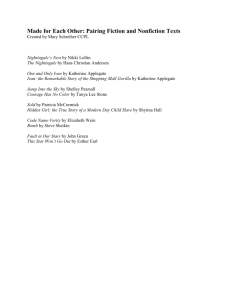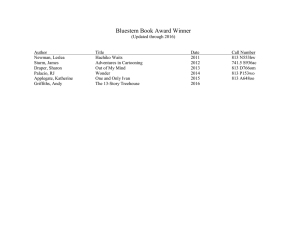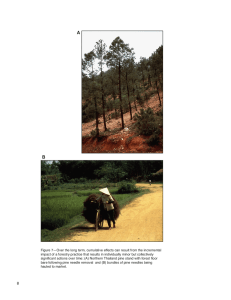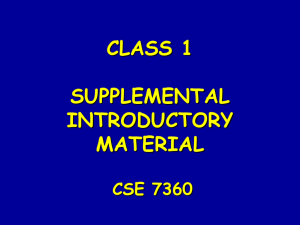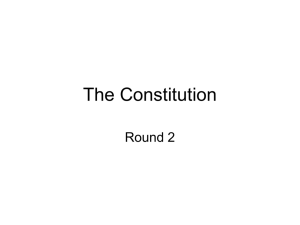Utilization and Marketing Projects Application ID Number 2007-113
advertisement
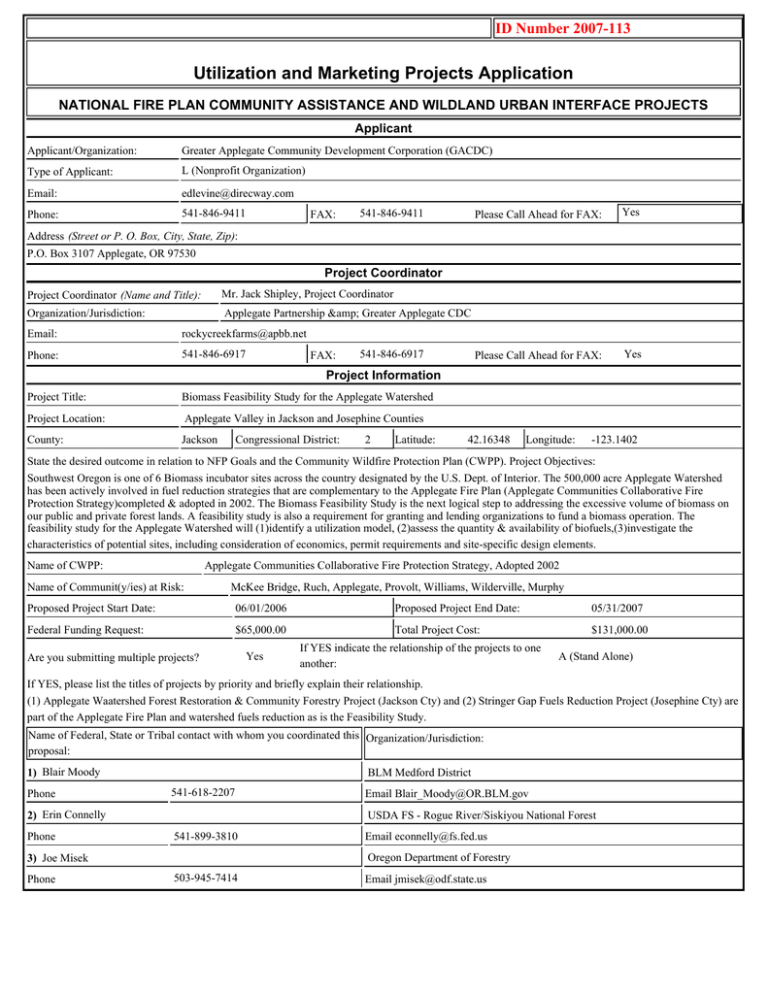
ID Number 2007-113 Utilization and Marketing Projects Application NATIONAL FIRE PLAN COMMUNITY ASSISTANCE AND WILDLAND URBAN INTERFACE PROJECTS Applicant Applicant/Organization: Greater Applegate Community Development Corporation (GACDC) Type of Applicant: L (Nonprofit Organization) Email: edlevine@direcway.com Phone: 541-846-9411 FAX: 541-846-9411 Please Call Ahead for FAX: Yes Please Call Ahead for FAX: Yes Address (Street or P. O. Box, City, State, Zip): P.O. Box 3107 Applegate, OR 97530 Project Coordinator Project Coordinator (Name and Title): Mr. Jack Shipley, Project Coordinator Organization/Jurisdiction: Applegate Partnership & Greater Applegate CDC Email: rockycreekfarms@apbb.net Phone: 541-846-6917 FAX: 541-846-6917 Project Information Project Title: Biomass Feasibility Study for the Applegate Watershed Project Location: Applegate Valley in Jackson and Josephine Counties County: Jackson Congressional District: 2 Latitude: 42.16348 Longitude: -123.1402 State the desired outcome in relation to NFP Goals and the Community Wildfire Protection Plan (CWPP). Project Objectives: Southwest Oregon is one of 6 Biomass incubator sites across the country designated by the U.S. Dept. of Interior. The 500,000 acre Applegate Watershed has been actively involved in fuel reduction strategies that are complementary to the Applegate Fire Plan (Applegate Communities Collaborative Fire Protection Strategy)completed & adopted in 2002. The Biomass Feasibility Study is the next logical step to addressing the excessive volume of biomass on our public and private forest lands. A feasibility study is also a requirement for granting and lending organizations to fund a biomass operation. The feasibility study for the Applegate Watershed will (1)identify a utilization model, (2)assess the quantity & availability of biofuels,(3)investigate the characteristics of potential sites, including consideration of economics, permit requirements and site-specific design elements. Name of CWPP: Applegate Communities Collaborative Fire Protection Strategy, Adopted 2002 Name of Communit(y/ies) at Risk: McKee Bridge, Ruch, Applegate, Provolt, Williams, Wilderville, Murphy Proposed Project Start Date: 06/01/2006 Federal Funding Request: $65,000.00 Are you submitting multiple projects? Yes Proposed Project End Date: 05/31/2007 Total Project Cost: $131,000.00 If YES indicate the relationship of the projects to one another: A (Stand Alone) If YES, please list the titles of projects by priority and briefly explain their relationship. (1) Applegate Waatershed Forest Restoration & Community Forestry Project (Jackson Cty) and (2) Stringer Gap Fuels Reduction Project (Josephine Cty) are part of the Applegate Fire Plan and watershed fuels reduction as is the Feasibility Study. Name of Federal, State or Tribal contact with whom you coordinated this Organization/Jurisdiction: proposal: 1) Blair Moody Phone BLM Medford District 541-618-2207 2) Erin Connelly Phone USDA FS - Rogue River/Siskiyou National Forest 541-899-3810 Email econnelly@fs.fed.us Oregon Department of Forestry 3) Joe Misek Phone Email Blair_Moody@OR.BLM.gov 503-945-7414 Email jmisek@odf.state.us Project Planning Information Name of Local Coordinating Group: Josephine-Jackson Local Coordination Group (JJLCG) For this project, explain the level of cooperation, coordination or strategic planning, through a "Local Coordination Group." If you have not worked with a local coordination group, why not? Coordination with JJLCG occurs through the Applegate Partnership in conjunction with the fireplan. List federal lands that are adjacent to the project and proximity. 350,000 acres = Medford District BLM and Rogue River/Siskiyou FS Will this project utilize fuels from an adjacent current fuel reduction project on federal lands or to one that is planned within the next three years? Yes Please indicate planned treatments and associated acres: Treatment Biomass Removal Acres 400000 Treatment Biomass Removal Acres 0 Treatment Biomass Removal Acres 0 Treatment Biomass Removal Acres 0 Treatment Acres 0 If you have a treatment type other than standard types above: Treatment Acres 0 Project Evaluation Criteria Applications for funding must include narrative responses that address the following criteria. Be sure you address every one briefly, yet thoroughly. 1. Increasing utilization, management and economic impacts of woody material removed in fuels management and forest restoration activities (60 points) A. Will biomass, thinnings or other surplus forest fuels be utilized? If so, in what manner and how much? How many acres will be treated? Are any of these acres within the wildland-urban interface? If so, how many? (20 points) Response: The Greater Applegate Community Development Corporation (a 501c3 organization) and the Applegate Partnership along with the US Forest Service, Bureau of Land Management and other public and private community organizations have formed an ad hoc group called the Applegate Biomass Study Group (ABSG). This study group was formed to research the feasibility of developing a community-owned and operated biomass facility for the Applegate Watershed to assist with the disposal of non-commercial fuels that are produced on private as well as public lands. All these lands are within the wildlandurban interface as identified in the Applegate Fire Plan. The Biomass Feasibility Study is the next logical step, and will help address the excessive volume of biomass on over 400,000 acres of combined public and private forest lands. A feasibility study is a necessary requirement for granting organizations and lending institutions to fund and support a biomass operation. B. Will the project improve the local economy in terms of jobs and sustainable economic activity? If so, how many and what type of jobs will be created or retained (i.e., wage-scale, full-time equivalent), and for how long? What percent of the jobs are expected to be filled from the local labor force? (10 points) Response: If the Feasibility Study demonstrates that a biomass operation is viable in the Applegate Watershed, facility development and operation will translate into construction jobs for development and employment opportunities for long-term operation, from collection of biofuels, transportation, processing and primary and secondary product distribution. We anticipate these jobs will be filled by the local labor force and will pay a family wage. The study will address these issues in detail. C. Are there private businesses involved in this project? If so, what are their roles and investment? How will the project be structured to minimize or eliminate te perception of use of public funding to create an unfair competitive advantage for those private businesses involved? (10 points) Response: Solicitation of the Request for Proposals has been advertised and distributed to private engineering firms in the Western U.S. As part of the Feasibility Study, we are requesting a market analysis, economic development potential and estimated capital cost and perceived financial risk. The long-range intent is to create a community-owned and operated facility. This includes the potential for securing private investments and/or partnerships. D. If the project involves new product development, what evidence is there for economically viable and sustainable markets? (10 points) Response: The Feasibility Study will determine potential economic viability and sustainable markets for biomass products. A 1989 study by The Rogue Institute for Ecology & Economy concluded that 110,050 acres of small diameter material (0-12 inches) are within 1000 feet of existing roads. Conservatively estimating 500 board feet/acre indicates a potential 55 million board feet of 0-12 DBH material in the Applegate Watershed within 1000 feet of existing roads. The new biofuels market has great potentia E. Can this project be offered as a model for other communities or businesses? If so, why and how will results of this project be disseminated or made available? (5 points) Response: The project can be offered as a model for other rural communities as well as private business concerns. We intent to disseminate the project results in media events and publications through the auspices of the Southwest Oregon Resource Conservation and Development Council, through environmental organizations and through BLM, FS and appropriate State of Oregon agencies and groups. F. How will the project be sustained beyond project timelines? If public funding will continue to be needed, why, how much, and for how long? (5 points) Response: The Feasibility Study is Phase I of a long-term development and sustainability plan. If the study determines that it is appropriate to proceed, we intend to design the treatment facility at 75% of capacity to accommodate the biomass that is produced within the watershed in any given year. Since the facility will be sized below total gross volume produced annually, the facility will be sustainable. 2. Taking Advantage of Existing Networks, previously-funded projects and knowledge. (20 points) A. How does this project take advantage of relevant, existing networks and the results from previously-funded projects or commercial operations? (10 points) Response: Substantial National Fire Plan dollars have been invested in the Applegate Watershed for fuels and fire hazard reduction work over the last decade. As a result, the GACDC and the Applegate Partnership are community-based organizations that have developed widespread networks with regional, state and federal organizations, both public and private. The Feasibility Study (Phase I) will continue to coordinate with these partners and, if Phase II is developed, the same policy will be pursued. B. Who and what (individuals, businesses, organizations, reports, studies, Internet sites, etc.) were consulted to ensure the best information available was used in designing this project proposal? (5 points) Response: We consulted BLM,FS, Natl Resource Conservation Service, Southwest Oregon Resource Conservation and Development Council, Univ. of Oregon Institute for Sustainable Environment, Oregon Dept. of Energy, state and federal websites,& attended conferen C. How did your group arrive at your cost structure for all of the main areas including: personnel, equipment, supplies, and overhead? (5 points) Response: We were advised by several sources, including Tad Mason of TSS Consultants (CA), regarding the average cost for feasibility studies. Other costs estimates are based on our extensive experience managing federal, state and foundation grants. 3. Expanding community participation and collaboration. (20 Points) A. Who are the partners and community members involved in planning and implementing the project? (5 points) Response: The GACDC & Applegate Partnership along with the US Forest Service, Bureau of Land Management and other community organizations formed an ad hoc group called the Applegate Biomass Study Group (ABSG). Members are lay citizens and professionals. B. How much cost-sharing is there for this project? (10 points) Response: Initially, the Applegate Partnership has contributed approximately $1,000 for conference attendance and related travel expenses. The GACDC has covered costs of printing and correspondance. Ad hoc committee membership has volunteered time at an estimated 2000 hours & will continue donating in-kind hours. Our intention is to apply for the balance of funds to Sustainable Northwest ($20,000) and Jackson County Title II Funds ($30,000). C. What are the direct community benefits that will result from this project? (5 points) Response: In addition to fuels reduction & production of biofuels, we anticipate the community-owned facility will create family wage jobs. Revenues above and beyond operating costs will be distributed to support community groups - food bank,libraries,scho Project Work Form Tasks Time Frame Responsible Party Publish & distribute Request for Proposals for Feasibility Study Completed 2/1/2006 GACDC Award Contract(s) 7/1/2006 GACDC and ABSG ad hoc committee Community Outreach & Education 7/1/2006 GACDC & Applegate Partnership Accept Completed Feasibility Study 1/1/2007 GACDC & Applegate Partnership Community Outreach & Education - Dissemination 4/1/2007 of Feasibility Study GACDC & Applegate Partnership & community and state partners Completion of Phase I activities 5/31/2007 GACDC & Applegate Partnership Initiate Phase II 6/1/2007 GACDC & Applegate Partnership Project Budget Cost Category Description Federal Agency Applicant Jackson Cty Sustainable Title II NW Partner 1 Partner 2 Partner 3 Total Personnel Subtotal $0.00 $0.00 $0.00 $0.00 $0.00 $0.00 $0.00 $0.00 $0.00 $0.00 $0.00 $0.00 $0.00 $0.00 $0.00 $0.00 $0.00 $0.00 $0.00 $0.00 $0.00 $0.00 $0.00 $0.00 $0.00 $0.00 $0.00 $0.00 $0.00 $0.00 $0.00 $0.00 $0.00 $0.00 $0.00 $0.00 $2,000.00 $0.00 $2,000.00 $1,000.00 $0.00 $5,000.00 $0.00 $5,000.00 $0.00 $0.00 $0.00 $5,000.00 $2,000.00 $5,000.00 $2,000.00 $1,000.00 $0.00 $10,000.00 $0.00 $0.00 $0.00 $0.00 $0.00 $0.00 $0.00 $0.00 $0.00 $0.00 $0.00 $0.00 $0.00 $0.00 $0.00 $0.00 $0.00 $0.00 $2,000.00 $0.00 $0.00 $0.00 $0.00 $2,000.00 $0.00 $0.00 $0.00 $0.00 $0.00 $0.00 $2,000.00 $0.00 $0.00 $0.00 $0.00 $2,000.00 $58,000.00 $0.00 $25,000.00 $17,000.00 $0.00 $100,000.00 $2,000.00 $1,000.00 $2,000.00 $1,000.00 $0.00 $6,000.00 $60,000.00 $1,000.00 $27,000.00 $18,000.00 $0.00 $106,000.00 $1,000.00 $0.00 $1,000.00 $1,000.00 $0.00 $3,000.00 $0.00 $10,000.00 $0.00 $0.00 $0.00 $10,000.00 $1,000.00 $10,000.00 $1,000.00 $1,000.00 $0.00 $13,000.00 $65,000.00 $16,000.00 $30,000.00 $20,000.00 $0.00 $131,000.00 $0.00 $0.00 $0.00 $0.00 $0.00 $0.00 Fringe Benefits Subtotal Travel Conference/Data Gather In-kind travel Subtotal Equipment Subtotal Supplies Postage, printing, etc. Subtotal Contractual Feasibility Study Facilitation & Outreach Subtotal Other Project admin In-kind volunteer hours Subtotal Total Costs Project (Program) Income 1 (using deductive alternative) 1 Program income is the gross revenue generated by a grant or cooperative agreement supported activity during the life of the grant. Program income can be made by recipients from fees charged for conference or workshop attendance, from rental fees earned from renting out real property or equipment acquired with grant or cooperative agreement funds, or from the sale of commodities or items developed under the grant or cooperative agreement. The use of Program Income during the project period may require prior approval by the granting agency.
